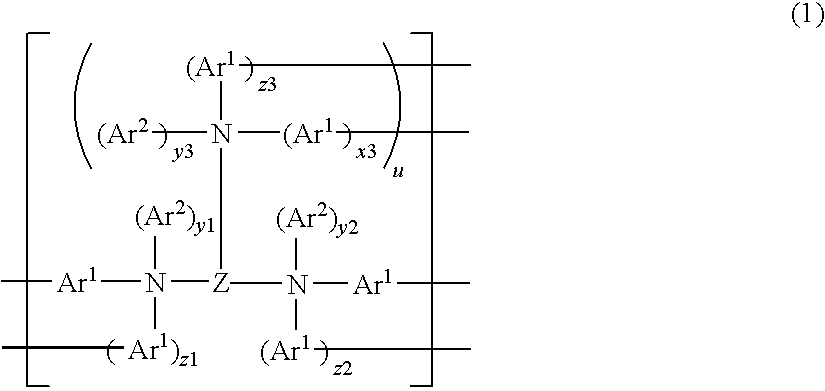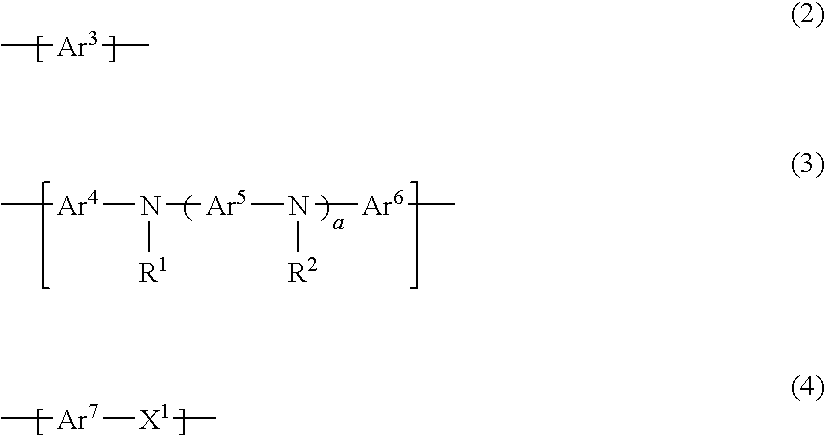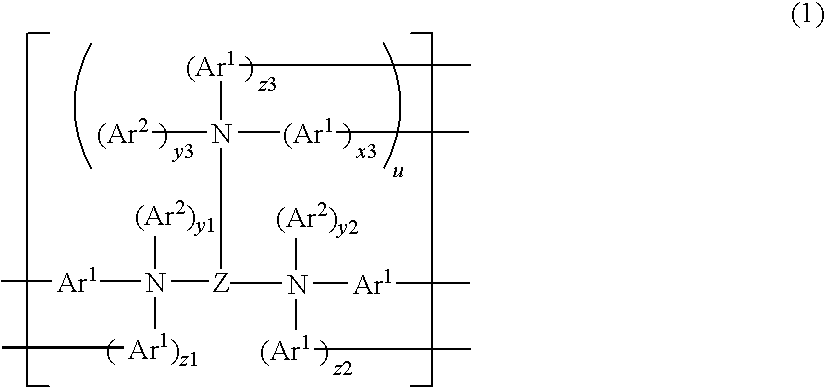Pyrene polymer compound and light emitting device using the same
a technology of pyrene polymer compound and light emitting device, which is applied in the direction of anthracene dye, perylene derivative, discharge tube luminescnet screen, etc., can solve the problem that the above-described polymer compound does not necessarily show a sufficient balance between, and achieve the effect of excellent balance between fluorescence intensity and light emission efficiency of light emitting devi
- Summary
- Abstract
- Description
- Claims
- Application Information
AI Technical Summary
Benefits of technology
Problems solved by technology
Method used
Image
Examples
synthesis example 1
Synthesis of Dibromopyrene
[0296]Into a solution prepared by dissolving 10.0 g (49.4 mmol) of pyrene in 250 mL of chloroform, a solution composed of 16 g of bromine and 100 mL of chloroform was dropped at 23° C. over a period of 7 hours while stirring. The mixture was stirred further for 1 hour, then, the resultant reaction liquid (containing crystal) was filtrated to obtain a crystal. This crystal was washed with chloroform, then, dried under reduced pressure to obtain 11.3 g of dibromopyrene (yield 63%, 1,6-dibromopyrene:1,8-dibromopyrene=59:41 (hereinafter, “dibromopyrene synthesized in Synthesis Example 1”)).
[0297]LC-MS (APPI-MS (posi)): 358 [M]+
synthesis example 2
Synthesis of Compound 1
[0298]To dibromopyrene (2.0 g, 5.6 mmol) synthesized in Synthesis Example 1 was added 4-t-butylphenylboric acid (2.2 g, 12.2 mmol), trioctylmethylammonium chloride (trade name: Aliquat 336 (hereinafter, referred to as “Aliquat 336”), manufactured by Aldrich, 0.74 g), palladium acetate (1.3 mg), tris(o-methoxyphenyl)phosphine (13.3 mg), toluene (58 mL) and sodium carbonate aqueous solution (17.8 mmol), and the mixture was stirred at 100° C. for 4 hours. The resultant reaction liquid was cooled down to room temperature, then, the reaction liquid (containing crystal) was filtrated to obtain a crystal. This crystal was washed with toluene, water and methanol in this order, then, dried under reduced pressure, to obtain 1.2 g (yield 47%) of a compound 1 of the following formula.
[0299]1H-NMR: (299.4 MHz, CDCl3): 1.45 (s, 18H), 7.59 (s, 8H), 8.00 (m, 4H), 8.22 (m, 4H)
[0300]LC-MS (APPI-MS(posi)): 467 [M+H]+
synthesis example 3
Synthesis of Compound 2
[0301]Into a solution composed of the compound 1 (1.15 g, 2.5 mmol) and chloroform (240 mL), a solution composed of bromine (0.9 g) and chloroform (12 mL) was dropped at 20° C. over a period of 30 minutes while stirring, and the mixture was further stirred for 6 hours. To this was added methanol (250 mL) and the resultant reaction liquid (containing crystal) was filtrated to obtain a crystal. This crystal was filtrated and washed with methanol, then, dried under reduced pressure to obtain a compound 2 (1.6 g, yield: 100%) of the following formula.
[0302]LC-MS (APPI-MS (posi)): 622 [M]+
PUM
| Property | Measurement | Unit |
|---|---|---|
| Fraction | aaaaa | aaaaa |
| Fraction | aaaaa | aaaaa |
| Current | aaaaa | aaaaa |
Abstract
Description
Claims
Application Information
 Login to View More
Login to View More - R&D
- Intellectual Property
- Life Sciences
- Materials
- Tech Scout
- Unparalleled Data Quality
- Higher Quality Content
- 60% Fewer Hallucinations
Browse by: Latest US Patents, China's latest patents, Technical Efficacy Thesaurus, Application Domain, Technology Topic, Popular Technical Reports.
© 2025 PatSnap. All rights reserved.Legal|Privacy policy|Modern Slavery Act Transparency Statement|Sitemap|About US| Contact US: help@patsnap.com



